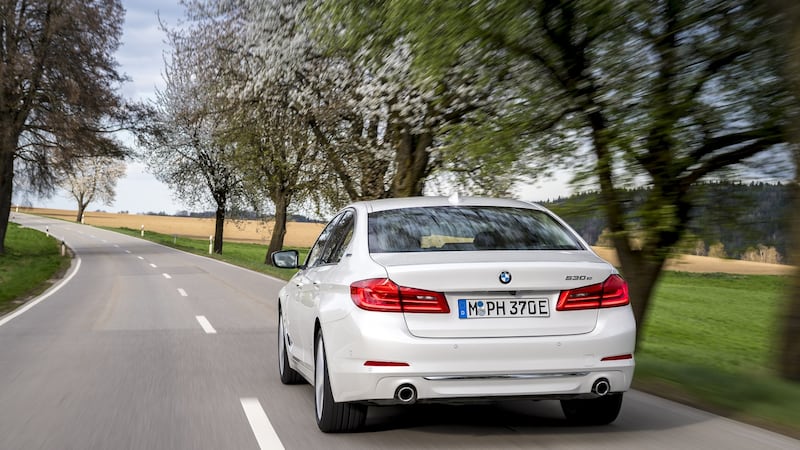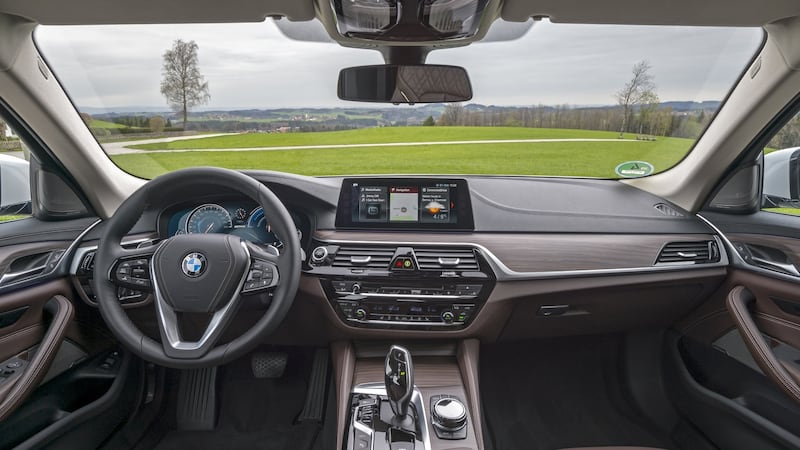When BMW quietly murmurs about the likelihood of major change coming, it's best to sit up and pay attention. The Munich firm has long prided itself on being at the very cutting edge of motoring, but in a particularly Irish context, it has form.
Back in 2008, when the then Fianna Fáil-Green government announced the introduction of the switch to Co2-based taxation for cars, the system introduced was all but identical to a proposal put to the government by BMW Ireland.
And, of course, BMW had a raft of low-Co2 diesel models ready to launch to take best advantage of the new system. So successful was the plan that the ubiquitous 520d (a pricey, premium model that qualified for rock-bottom tax rates) became emblematic of the inability of officialdom to see that the carmakers were thinking way ahead of the legislators.


Could that be happening anew? Diesel power is smack in the middle of the taxman’s crosshairs right now, and although any change that comes is likely to be rather slower than the almost-overnight change to the tax system in 2008, nevertheless, it will come and the black pump will be punished for its supposed crimes against the environment. BMW, for one, seems ready.
Just as it was ready in 2008 with low-Co2 diesels, BMW is now prepared with an expanding range of low Co2 and low nitrogen oxide iPerformance plug-in hybrids. We've already seen the plug-in 3 Series, the X5, the 7 Series, the 2 Series Tourer and, in China only for now, a plug-in X1. But this feels more significant. This is a 5 Series with a plug.
Take seriously
The 530e iPerformance (rather confusingly badged on the c-pillar as an eDrive model) isn’t the first part-electric hybrid 5, but it is the first one that’s worth taking seriously. It uses, effectively, the same part-electric powertrain as the 330e and the X5 40e, so you have a 184hp 2.0-litre turbo petrol engine, combined with a 95hp electric motor stuffed betwixt engine and eight-speed auto gearbox, for a system total of 252hp and 420Nm of torque.
Charge up the 9.2kWh battery stack (BMW can supply you with a 3.7kW wall charger which will do that in about three hours) and you can go for a claimed 50km without burning any dead dinosaurs, and a claimed 650km if you combine the battery and the truncated fuel tank. BMW claims a whopping 141.2mpg fuel economy and 46g/km of Co2.
As with all other plug-ins, the actual performance depends hugely on where and how you drive. For the record, we zeroed our test car’s trip meter with the battery showing 33km of range from a not-quite-full charge, and attempted to drive around rural Bavaria and suburban Munich as if we were normal, regular commuters.
We weren’t driving with the saintliness of an economy-run expert, but neither were our trousers on fire nor our licences at risk of confiscation. The results?
We ran for 30.5km on just the batteries, and then the regular hybrid mode kicked in for the remaining 83km of our test route. When we reached our destination, the trip computer showed average fuel consumption of 5.7-litres per 100km, or 48.7mpg.
Is that good? Is that bad? Well, again it depends. Clearly if you drive all day long in the outside lane of the M8 or M1, then no, it isn’t and a more long-range 520d is still your best bet.
If, though, you live in town, remember to plug your 530e in regularly, and don’t habitually do long journeys, then actually yes – it’s pretty much ideal and you will probably do most of your journeys (BMW estimates its urban customers only do journeys of about 30km on average) on just the batteries, emitting nothing more than a bit of tyre noise.
Strongest point
And noise is actually the 530e’s strongest point. It is an exceptionally refined car in which to travel, with the 2.0-litre petrol engine only becoming overly vocal when full acceleration is called for (and which is boosted by the electric motor when you ask for snap power for overtaking).
Conversation between the front-seat occupants can take place in hushed tones, and if the cabin is a bit too heavy on the borrowed-from-the-7-Series styling, then you can take solace in the fact that it's roomy, exceptionally comfortable and has quality levels that would put even Audi to the sword.
The only drawback is that the boot, at 410 litres thanks to the battery stack, is too small for a car this big, and that just occasionally you can feel the suspension start to struggle slightly with the extra weight.
Hang on, the only drawback? Not quite. You see, we recently praised the plug-in 330e because (a) it’s a good car and (b) it’s up to €4,000 cheaper than an equivalent diesel 320d.
The 530e has no such advantage, quite the reverse in fact. Even with the €7,500 reduction in price thanks to a claw-back of vehicle registration tax and a grant from the Sustainable Energy Authority for buying an electric car, the 530e, at €55,900, is more expensive than a 520d, which is already quite a lot more expensive than its direct predecessor.
The 330e, good though it is, currently only accounts for around 10 per cent of Irish 3 Series sales, so is the 530e going to crash and burn, sales-wise?
Perhaps not. There is a quiet confidence among the BMW people about this model, in the Irish context, even though currently you cannot claim back VAT on petrol as a business user, and there are few incentives at the corporate tax level for putting employees into electric or hybrid cars.
It’s almost as if BMW Ireland know’s what’s going to happen next . . .
The lowdown: BMW 530e
Price: as tested, €55,900.
Power: 252hp.
Torque: 420Nm.
0-100km/h: 6.2sec.
Top speed: 235km/h.
Claimed economy 141.2mpg (2.0-l/100km).
CO2 emissions: 46g/km.
Motor tax: €170 per annum.
Verdict: Half-electric 5 is ultra-smooth and refined, but can it really supplant diesel in the Irish market?
Our rating: 4/5
Come on BMW, let’s have some proper engines.
Among all this talk of hybrids and iPerformance models, it’s good to know that BMW can still make a proper, real engine. One (two in this case) that can raise the hairs on the back of your neck and get your right foot involuntarily twitching.
The first is the revised 440i coupe, which (as does the whole 4 Series range) gets slightly updated styling, some tweaks to cabin quality and materials and, more crucially, reworked suspension and steering.
Short of the hyper-fast, hyper-expensive M4, the 440i is the top of the range, and it uses a classic-style BMW straight-six petrol engine, with turbos, that makes a healthy 326hp and sounds, when you accelerate hard, as if someone is tearing a gigantic tapestry next to your left ear.
Glorious sound, wonderful performance and, thanks to that tweaked chassis, impressive stability and proper driver entertainment on the soaking wet Bavarian roads of our test route. When someone next complains that cars aren’t fun anymore, show them this.
Or show them the M550i – but you’ll have to show them at a distance as there’s no right-hand drive production planned. Designed to fill the gap between the regular 5 Series and the incoming new M5, the m550i looks subtly mean and packs a 462hp punch from its 4.4-litre twin-turbo V8 engine.
Thanks to xDrive four-wheel drive, it is immensely sure-footed, and that engine punches very hard indeed (faster than the old M5 to 100km/h, and we saw an indicated 260km on an empty stretch of Autobahn).
Yet it’s also limo-comfy and quiet when you turn down the wick and settle into a cruise. Not an especially relevant car, perhaps, but enormously good fun and full of impressive engineering. Proper combustion engine engineering. None of that battery stuff.










